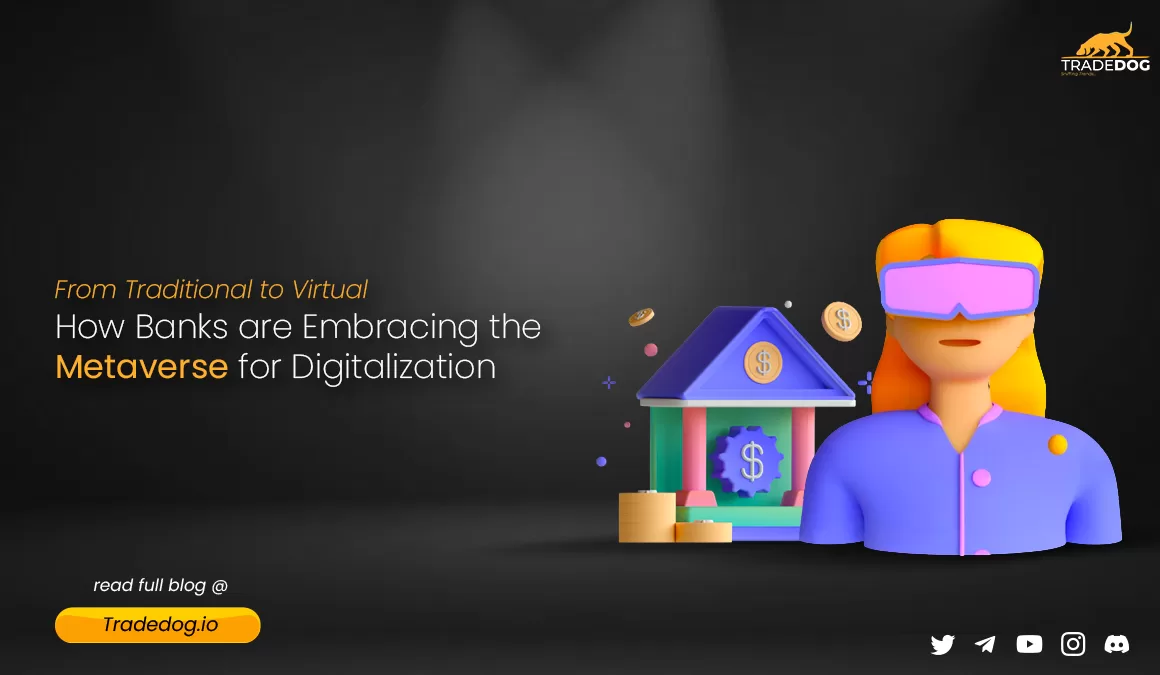Quick Links
Metaverse and banking – sound like two completely unrelated worlds right? I mean in one place you can be anyone and live your virtual life on your terms and when it comes to banking, it’s just another nightmare of going to the branch and sitting there for hours to get something done. The metaverse, as we all know is a virtual universe that integrates and seamlessly blends digital and physical realities, and has been gaining popularity in the last few years. With its potential to revolutionize industries and redefine human interactions, it’s no wonder the banking sector is eager to explore the opportunities that the metaverse presents. In this blog, we delve into the potential benefits, challenges, and case studies of banks venturing into the metaverse.
How the Metaverse Could Benefit Banking
The metaverse can provide banks with an innovative platform to engage with customers, improve user experiences, and optimize business operations. Some key advantages include:
Enhanced customer engagement
By creating immersive, interactive experiences, banks can attract and retain customers more effectively. Having a virtual presence where the customers can interact with and experience the banking services as they would in a real branch, would make the customer experience better.
Streamlined operations
The metaverse can enable seamless integration of various banking services, allowing for increased efficiency and cost savings. This can be conducting a virtual KYC with the customers visiting the virtual branch or escalating and resolving requests from customers.
Expanded market reach
Virtual banks can operate borderless across geographical boundaries, potentially reaching a global clientele. This gives them the option to expand without having any physical branches and onboard new customers at a lower cost.
Innovative financial products and services
The metaverse can facilitate the creation of new digital assets, such as cryptocurrencies and NFTs to provide various services such as FDs with smart contracts, instant loans, encrypted cards that can use fiat as well as any cryptocurrency for transactions, and open up new revenue streams for banks.
Challenges and Limitations for Banking in Metaverse
Despite the potential benefits, there are several challenges and limitations to consider:
Security concerns
Ensuring the safety and privacy of customer data in the metaverse is crucial, especially given the increasing threat of cyberattacks. Banks will need to ensure that there is no scope for identity theft or scope for bugs through which sensitive information can be accessed by hackers or cybercriminals.
Regulatory hurdles
As there is still strong resistance from banks and financial institutions against cryptocurrencies and decentralized platforms, the metaverse which is continuously evolving needs to adapt to new and existing regulations for the use of virtual financial services.
Technical barriers
Developing and maintaining the necessary infrastructure for metaverse banking requires significant investment in technology and skilled personnel. Also, the staff needs to undergo training on how to operate in the metaverse, handle the customers, and the scope of its use.
User adoption
Convincing customers to embrace virtual banking experiences may be challenging, particularly among those who are less tech-savvy or hesitant to adopt new technologies.
Case Studies of Banking in Metaverse
Banks are already using the metaverse for digitalization and transformation, some examples include –
HSBC
HSBC has been actively exploring the metaverse and its potential applications in banking. In 2021, the bank collaborated with The Sandbox, a decentralized virtual world, to create a virtual HSBC branch. This initiative enables customers to access financial services, educational resources, and customer support within the metaverse, providing a unique and engaging experience.
JPMorgan
In October 2021, JPMorgan Chase announced the launch of its Onyx Lounge in the metaverse, built on the platform Decentraland. The virtual lounge serves as an innovative networking and educational space for clients, offering access to exclusive events, presentations, and content.
BNP Paribas
BNP Paribas has been an early adopter of virtual reality technology, leveraging it for employee training and development. The bank has also explored the metaverse for customer engagement, partnering with a virtual reality platform to create immersive financial education experiences for users.
Bank of America
Bank of America has ventured into the metaverse by establishing a presence in virtual worlds like Decentraland and Cryptovoxels. The bank aims to offer a range of financial services, including virtual banking branches, access to digital currencies, and support for NFT (non-fungible token) transactions. This move demonstrates Bank of America’s commitment to embracing emerging technologies and staying at the forefront of digital transformation in the banking sector.
KB Bank
KB Bank of South Korea introduced a VR version of its branch in the Metaverse where employees would be represented through avatars. It will allow Employees and consumers to speak directly with each other.
Practical Outcomes of Banking in Metaverse
Banks like HSBC, JP Morgan, BNP Paribas, and Bank of America are leveraging the metaverse for enhancing customer experiences, streamlining operations, and exploring new revenue streams. By embracing the utility of Metaverse, these institutions are positioning themselves as innovative leaders in the industry.
However, they also face several challenges, such as ensuring the security and privacy of their metaverse offerings, navigating regulatory compliance, and investing in the necessary infrastructure and talent to support these initiatives. As more banks venture into the metaverse, they must continually adapt to address these challenges and stay ahead of the competition.
Future Implications and Conclusion
As the metaverse continues to grow and gain traction, its impact on the banking industry is likely to be profound. Banks that proactively embrace this technology will be able to unlock new opportunities for growth, streamline operations, and enhance customer experiences. However, they must also be ready for the inherent challenges, including security risks, regulatory uncertainty, and user adoption barriers.
In conclusion, the banking landscape can be reshaped with the help of the metaverse, offering innovative solutions and opportunities. Banks ready to adopt and invest in this emerging technology will be better positioned to thrive in an increasingly digital world. As more financial institutions explore the possibilities of the metaverse, we can expect to see a greater variety of virtual banking services, products, and experiences. It is crucial for banks to stay ahead of their competitors by understanding and addressing the challenges, while also leveraging the numerous benefits that the metaverse has to offer. Ultimately, the successful integration of the metaverse into the banking sector will depend on the industry’s ability to innovate, adapt, and maintain a customer-centric approach in this exciting new world of mixed reality.









